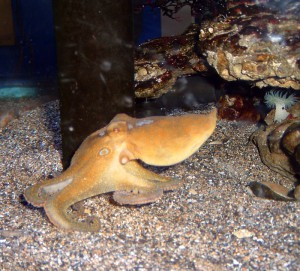In a Letter in Nature magazine last week (August 13, 2015), researchers published surprising findings from a genome analysis of the octopus. As a result, we now know that this invertebrate has more than just behavioral oddities with which to amaze.
In their publication, C. Albertin et al. report the results of genome sequencing of the California two-spot octopus, Octopus bimaculoides. They did not find the predicted whole-genome duplication, but rather an unexpectedly large genome with many rearrangements, and two gene family expansions that were previously thought to exist only in vertebrates.

The Research
Albertin et al. sequenced the O. bimaculoides genome using a whole-genome shotgun approach, and then annotated it using extensive transcriptome sequences from 12 tissues. They estimate that the genome assembly incorporated 97% of protein-coding sequences, and 83% of the entire 2.7gigabase genome. The remaining sequence was composed largely of repetitive elements.
The Results
Albertin et al. report that “the core developmental and neurological repretoire” of the octopus is generally that expected for an invertebrate bilaterian, with a relatively standard set of developmentally necessary transcription factors and signaling genes. The authors say that this suggests that evolution of the cephalopod body did not rely on expansion of these “toolkit genes”.
However, the octopus genome showed unexpected genetic development in two gene families previously considered the domain of vertebrates; 1) the protocadherin, and 2) C2H2 zinc-finger transcription factor families. Statistical analysis of protein domain distributions across a range of animal species led the researchers to these gene family expansions in the octopus.
The octopus genome encodes 168 protocadherin genes, extraordinary when compared to other invertebrates; Crassostrea gigas (oyster) and Capitella (polychaete worm) genomes contain just 17–25 protocadherin genes. These genes encode cell adhesion molecules important in development and survival of mammalian neurons, in determining synaptic specificity. A single protocadherin gene is found in invertebrates such as the acorn worm and sea urchin, but not in fruit flies or nematodes. This disappearance is explained as gene loss.
Like the octopi, vertebrates also show a remarkable expansion of protocadherin genes, generated by complex splicing from a clustered locus rather than from tandem gene duplication (1). Thus both octopi and vertebrates have independently evolved a diverse array of protocadherin genes.
Watch
This video accompanies the Nature article: Octopus Genome: Suckers and Smarts.
You’d have to really not like animals to not be surprised and amazed with the octopus’ ability to rapidly make a whole-body color change, it’s seemingly analytical abilities (videos show moving plants to hide the entrance to a vessel the octopus lives in, and reports of octopi leaving their tanks to capture prey from other tanks at their aquarium homes), as well as reports of their ability to chemosense (basically to taste) with the suckers on their 8 legs. With this report in Nature, we now learn that octopi also have some genetic tricks up their (8) sleeves.
More Octopi Footage
ARS Technica posted this article on the octopus genome sequencing that includes some really amazing video footage of octopi antics (warning: some predation is involved).
Reference
Albertin, C. et al. (2015) The octopus genome and the evolution of cephalopod neural and morphological novelties. Nature 220 (254): doi:10.1038/nature14668
